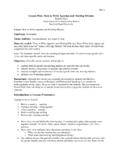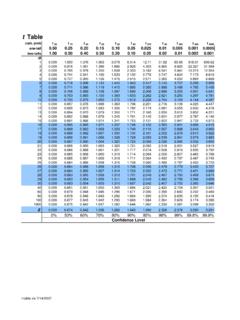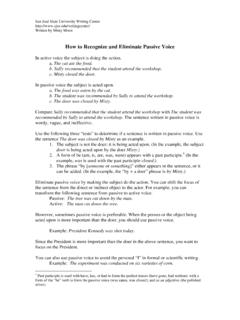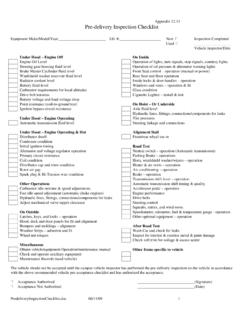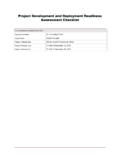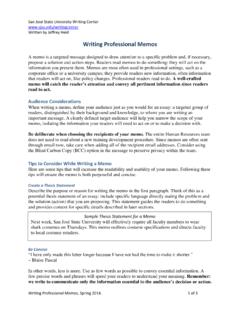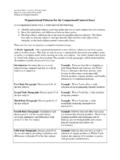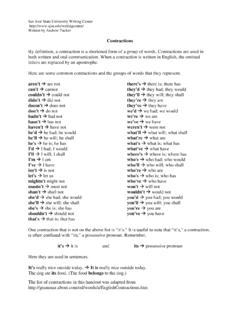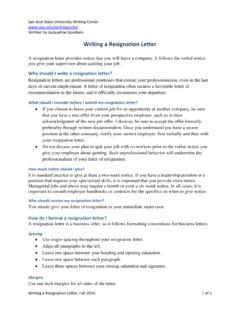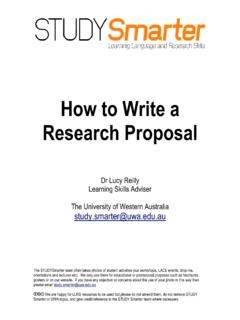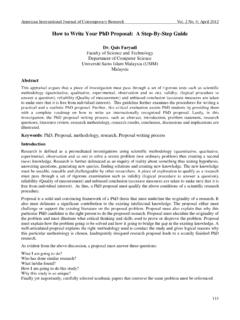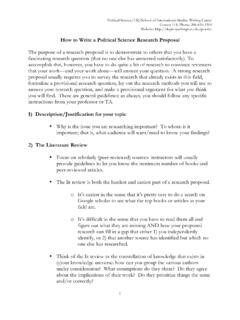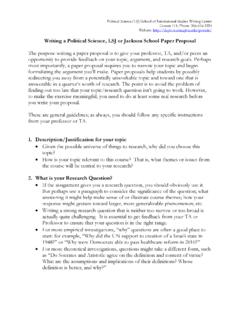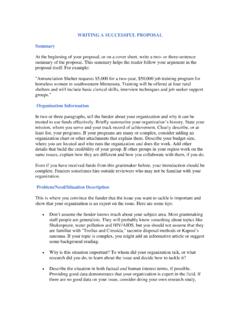Transcription of Writing a Research Proposal
1 Academic Skills 13 MELB Go for excellence 1. Your proposed topic should address a significant problem and, therefore, advance the state of knowledge in that field. 2. You have identified an appropriate methodology and underlying theory to address the problem, including data collection methods and equipment, if required. 3. Your methods of data analysis are outlined and appropriate to your data set so that you can draw useful conclusions from your work. 4. You have an organised plan for your work, including a timeframe. Writing a Research Proposal A guide for Science and Engineering studentsA Research Proposal has several inter-related purposes: Writing an effective Research Proposal also trains you in a valuable skill required to operate effectively in both academia and industry after you graduate.
2 You are presenting a reasonable thesis idea or hypothesis, the significance of which you have demonstrated by relating it to relevant literature in the field of enquiry. You are also proposing a methodology to investigate the problem with clear steps leading to a reasonable conclusion. The main criterion for the award of a PhD is that your thesis constitutes an original contribution to knowledge in a particular field. Remember that you may eventually refine or even abandon your initial topic as your Research progresses, but the Proposal demonstrates that you are aware of the process of enquiry and experimentation that leads to a thesis outcome. Finally, the Research questions, significance and methodology that you write in your Research Proposal will help you refine your Themis ethics Research application.
3 The structure of a thesis Proposal The structure and size of your Research Proposal will vary depending the requirements of your Faculty or School so the initial step is to find out departmental guidelines and requirements. Nevertheless, there are certain elements that any Research Proposal requires and these should be presented in the following order. Title or Cover Page: identifies the Research project title, the student researcher, the institution, department, and the project mentors or supervisors. The title should be brief and descriptive and may use a colon (:) to separate the topic from the focus ( Stormwater Harvesting: managing the hazards of surface water pollution by run-off).
4 Table of Contents: lists the sections of the Research Proposal (headings and indented sub-headings) and the corresponding page numbers. Abstract: outlines the essence of the Research project in around 150 200 words. It describes the purpose and motivation for the study, and a statement of the problem, the data collection methodology and analysis, and the significant results and implications of the Research . Introduction: provides background information for the Research ( the problem being addressed) and is typically structured from general information to narrow or focused ideas; whereupon your Research question/s or hypotheses are presented. The Introduction should be about 10% of your Proposal .
5 Imagine you are Writing for a general science reader rather than an expert audience. The Introduction includes a brief review of relevant literature or knowledge in the field, so that you are able to present the gap in the existing knowledge and, therefore, the significance and originality the purpose and aims of your Research . Finally, articulate the scope of your Research ; or what you will not be doing, so as to limit your task. Research Question/s: what is the primary question you are trying to solve? It may be a hypothesis/hypotheses or Research question/s and is usually a few sentences (in statement and/or question form) that articulate the essence of your project and its scope.
6 Land use and terrestrial carbon storage in western Victoria from 1890-2020: A historical reconstruction and simulation study. Research Design or Methodology: includes a description and rationale for the methods of data collection and analysis, and the materials used when solving the problem. When and how will you know, for example, that sufficient experimentation has been done, and sufficient and valid data analysed, to support or invalidate the original hypothesis? This section includes the dataset/s, calculations, equipment, calibration graphs, and procedures to be used, lists project limitations and outlines how ethical considerations of the Research have been considered.
7 Typically, it uses subheadings ( Subjects, Instrumentation, Data Collection, Methods of Analysis etc.) and is written with a future aspect, The Research will initially examine water treatment processes Preliminary Results: details any results that you may already have as a result of previous Honours or Masters Research work, perhaps also from a pilot study. It is important to relate these results to the critical framework of your intended PhD Research . Timetable / Plan: lists the stages of the Research project in timeline, spreadsheet or tabular format, and the deadlines for completion of these stages or tasks. You should include any challenges to completion that you anticipate facing.
8 Thesis Outline or Structure: outlines the proposed chapters of the thesis and the content of each chapter in several lines or a paragraph, including a Table of Contents. Academic Skills 13 MELB Go for excellence V2 1012 JH Significance and Implications of the Study: relates the intended or expected outcomes of your Research to the original aims expressed in the Introduction so that the significance of the study and the contribution to knowledge is apparent. List of References: lists all the resources cited in your resource Proposal using a referencing format appropriate to your faculty or discipline. Do not list resources that are not referred to in your Proposal .
9 This is a good time to begin using a bibliographic tool such as EndNote to track all the references for your study. See for further information about EndNote. Writing the Research Proposal How to write : Remember that you do not need to write your Research Proposal in the order in which it will be read. In fact, you might begin the Writing process with a concept map drawn up on large-size paper in landscape orientation. Give your concept map a title at the top of the paper and then write appropriate headings for the different sections of the Research Proposal ( Introduction, Methodology, Conclusion) and draw boxes around these headings so they look like pages of a book. Now, add anything you think you will need in these boxes ( figures, graphs, references, topic sentences) and use colours to highlight different kinds of content.
10 Because this is a creative brainstorming session don t restrict your ideas and don t be concerned with neatness. The idea is to gain an impression of the whole Proposal and to draft your chapter outline. The next step is Writing the rough draft. Start with the Methodology section and remember to provide enough information for the experiments and data collection to be replicated by someone else, but nothing more. Then, ask yourself, what is different about your proposed method? What kind of Research are you proposing? This will give you your sub-headings. Experimental equipment, materials, method Modeling assumptions, mathematical tools, method Computational inputs, computational tools, method.
